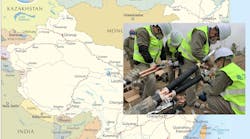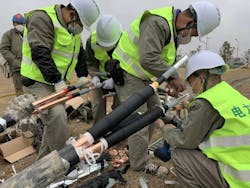As the coronavirus overwhelmed Wuhan in China’s Hubei Province in January, Eaton experts were part of the team that delivered a new healthcare facility in just 10 days. Howard Liu, president of the Asia-Pacific region for Eaton’s electrical sector, and Robert Stroescu, vice president for light commercial and construction at Eaton, discussed with Machine Design how the company responded locally to meet the extraordinary demand, how they worked to build a hospital and keep their own workers safe, and what we have already learned from this pandemic that may help in the future.
Machine Design: Talk about the first call from the Wuhan Power Supply team in China. What was their approach to the situation, and how did they explain their specifications for this project?
Howard Liu: On Jan. 24, the day after the government announced plans to build Huoshenshan Hospital, the hospital construction plan was specified. Because of our long-term successful collaboration with local contractors and partners, they turned immediately to our team in China for our products.
This was right before the Chinese Spring Festival and many people were on leave, as is normal. Our regional team members from logistics, manufacturing and our distributors responded immediately to check for inventory and arrange shipment and installation. We fully leveraged our resources in different departments, office sites and cities.
MD: The process of providing reliable power to any hospital is a daunting one. To do this in such a short period of time is remarkable. What were some of the specific challenges?
HL: I would say the major difficulties were the urgency of the project, and logistics and production limit due to the virus breakout and the holiday.
While people were on leave for the holiday, our employees and partners came back immediately to work when they received the phone call. It was a time when our customers and community needed us most, and everyone was on this mission with their full heart.
Our teams coordinated with several distributors to consolidate inventory to deliver products to the Huoshenshan Hospital. When our engineers had difficulties getting onsite for [uninterrupted power source] commissioning, the team improvised and instructed successful commissioning via video conference.
I want to highlight that both Eaton employees and our partners were closely working together on this, demonstrating highly efficient and effective teamwork. This is a real-life case of our brand promise—we make what matters work.
MD: For your team on the ground, what was this experience like? How did everyone work to stay safe even as they were trying to provide relief to others?
Robert Stroescu: Eaton has maintained operations during the global COVID-19 crisis because our products are critical to our global infrastructure, just as these construction projects in China for the two new field hospitals demonstrate. Our electrical equipment forms the backbone of safe, reliable electricity supply for numerous critical industries and our mission-critical support is foundational to hospitals, first responders, data centers and more.
We meet this responsibility with safety of our employees as our first priority. Our focus continues to be on protecting the health and well-being of our employees, customers, suppliers and the communities in which we work.
Across the organization, we take very seriously the need to reduce the spread of the virus by limiting the number of employees working close together. We are taking precautions to reduce risk, including social distancing, staggered shifts, increased cleaning and disinfecting protocols, and monitoring of the health and well-being of our employees.
MD: How are the lessons from the experience in Wuhan applicable for future uses, either as it pertains to the U.S. or for other future projects?
RS: Our recent work in China and around the world is informing best practices that we’re applying here in the U.S. Beyond projects during the pandemic, we have decades of experience in supporting electrical system construction and maintenance with urgent timelines. There are important lessons that are clear for fast-paced projects requiring energy resiliency and reliability:
A robust partner network was instrumental to support the fast-tracked construction in China. Whether supporting new construction or maintaining existing facilities, you need partners that can step in at a moment’s notice to provide the solutions and resources to get the project completed in a timely manner.
During a crisis or natural disaster, both your employees and those working at your support organizations may be affected. It is critical that the suppliers you select have the resources available to source people and materials. Eaton has regional manufacturing capabilities that provide expert resources, rapid support and delivery, as well as customized equipment for immediate needs. Local market knowledge [and] in-depth technical capabilities, as well as custom manufacturing, can help expedite priority projects.
Other Lessons Learned
Modular and prefabricated solutions can fast-track construction. Electrical systems are essential to construction projects. Prefabricated and modular solutions can help reduce installation time, inventory and costs. For example, many power distribution assemblies can be so big that the walls of buildings are built around them, or they need to be installed and energized in order to power a building before setting up other building systems.
For this reason, meeting project timelines and budgets can hinge on fast and efficient delivery and installation of power system components. By fully designing, integrating and testing these critical electrical components in a controlled factory setting, prefabricated solutions can help accelerate construction projects.
Emergency plans should be regularly assessed. Critical facilities have emergency plans in place and emergency power systems that need to be regularly assessed and tested. Eaton is helping healthcare facilities address this challenge in regions around the world. These emergency power systems are critical in COVID-19 treatment centers, which rely on critical life support, ventilation and respiration systems for patient care.
Contingency plans should also ensure that your facility’s electrical infrastructure could support the change in energy consumption caused by a mass addition of sensitive electronic healthcare devices.
Inspect and test emergency systems to hold up during moments of crisis. Inspect electrical and mechanical rooms to ensure your systems are working as planned. Mandated testing is the minimum requirement. Facility managers should closely inspect their emergency and backup power systems to ensure they can continue to provide the highest levels of treatment should utility power be interrupted.
Treatment facilities demand backup power systems that can maintain operations for multiple days. This challenge underlines the importance of making sure infrastructure is not only up-to-date and code-compliant, but also ready for what’s next. For this reason and more, organizations should keep a closer eye on the condition of their electrical infrastructure.

